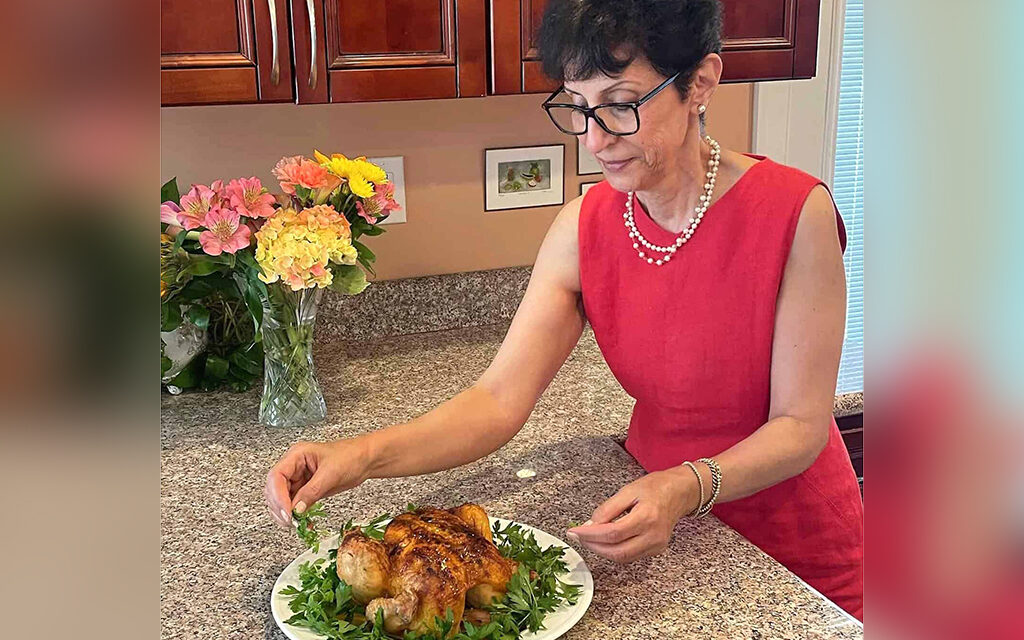By ETHEL G. HOFMAN
JNS
Jews the world over will celebrate Rosh Hashanah beginning the evening of Oct 2 this year. Sweet dishes are served to welcome in 5785 with wishes for a sweet year ahead. And for peace! After a year like this one, the Jewish people need some resolution. They need the estimated 100 hostages returned from nearly a year of captivity in the Gaza Strip after the Hamas terrorist attacks and atrocities in southern Israel last October. They need calm in Israel’s north and the country’s borders to be secure. Jewish people need the world to put away its anger at us and to focus on resolving regional ills caused by its main puppeteer, Iran.
Shani Feinstein, who lives in the Philadelphia suburbs, knows that firsthand. Vivid memories remain of her last Rosh Hashanah in Tehran in 1979. She had just graduated college and was settled in a job. She recalls that “demonstrations against the shah had started in June, but we didn’t pay much attention. Then, before Rosh Hashanah, floods of angry people—men and women—spilled into the streets. They became more intimidating. The ayatollah made empty promises. Women had to cover Western clothing and wear a chador—a full, body-length black garment—or face punishment. It was the end of freedom under the shah’s regime.”
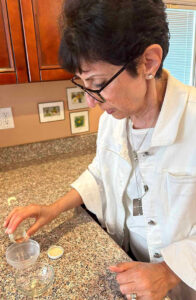
Shani Feinstein measures saffron for a holiday dish. Photo courtesy of Bruce Feinstein.
The Jewish community—between 70,000 and 80,000 people in all and one of the oldest in the diaspora—laid low so as not to draw attention to themselves. Before going to shul, Sion, her father, would wrap his tallit bag in a newspaper. Shopping at the market for all the holiday foods, Shani’s mother, Tuba, wore a chador and stayed to herself. That year, Rosh Hashanah was celebrated quietly with family.
The political atmosphere grew darker in the country. Most Jews lived in Tehran, with lesser concentrations in Shiraz, Kermanshah and Isfahan. Shani recounts that “the shah had left, and the ayatollah returned and replaced the government.” She told her mother that she didn’t want to live in such an environment. But where to go? Communication with Israel had been cut off. In February 1980, word spread that the Chabad-Lubavitch movement was ready to take young people out of Iran to New York. The fear was of another Holocaust. Shani went to the passport office every day for two months until she received her passport. “It was the happiest day of my life,” she says.
Eventually, the rest of her family came over, save for one sister. Shani went on to marry and have three children.
Shani carries on the Sephardic culinary traditions she grew up with, reminiscent of a home she can no longer see. There are no Western-style meal courses in Iran. No soups, no challah, no honey or apple cake, as in Ashkenazi holiday meals and tradition. Rather, a sumptuous array of Rosh Hashanah dishes is set out on a long table, buffet-style. Symbolic foods consist of flatbreads, pomegranate seeds, pumpkin, red beans, leeks and dates—for a sweet year and for the eradication of enemies.
A simple salad reflects the Iranian use of just a few fresh ingredients. Alongside, a tray of assorted fresh herbs like fresh tarragon, watercress, radishes and green onions is typically served to dinner guests. Dessert comes in the form of baklava, accompanied by a platter of seasonal fruits and nuts.
PERSIAN SALAD (pareve)
Serves 4-6
Cook’s Tips:
- May substitute any fresh herb such as mint, watercress or parsley for the cilantro.
- Two to three limes, depending on size, yield ¼ cup lime juice.
- Limes and lemons yield more juice at room temperature.
Ingredients:
3 to 4 Persian cucumbers cut into ½-inch pieces
2 to 3 medium tomatoes, cut into wedges
¼ Vidalia onion, finely chopped
3 tablespoons chopped cilantro
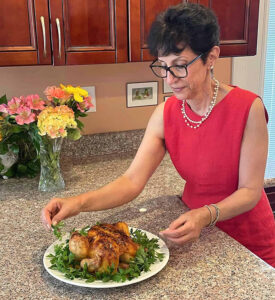
Shani Feinstein with a platter of roasted stuffed chicken. Photo courtesy of Bruce Feinstein.
Dressing:
¼ cup freshly squeezed lime juice
3 tablespoons extra-virgin olive oil
pinch of salt and 3 to 4 grinds freshly ground black pepper
Directions:
Place all ingredients into a serving bowl. Set aside.
In a small bowl, whisk together the dressing ingredients. Pour over the vegetables in a bowl.
Serve chilled or at room temperature.
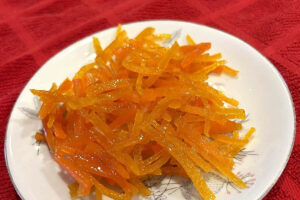
Candied orange peel. Photo courtesy of Bruce Feinstein.
RICE WITH CANDIED ORANGE PEEL (pareve)
Makes 6-8 servings
Cook’s Tips:
- Use store-bought shredded carrots.
- Slivered orange peel is available online on Amazon. If preparing at home, make sure no white pith remains on the peel.
Ingredients:
1 cup slivered orange peel
4 cups water, divided
1 cup carrots, cut into thin strips
2 tablespoons vegetable oil
1 cup sugar
½ teaspoon saffron dissolved in 2 tablespoons hot water
3 to 4 cups hot cooked rice
Directions:
In a medium saucepan, place orange peel and 3 cups water. Bring to a boil over high heat.
Cook for 10 minutes. Drain. Rinse with cold water and set aside.
In a small skillet, sauté the carrots in oil over medium heat for 5 minutes. Set aside.
In a separate saucepan, place the orange peel, carrots, sugar and 1 cup water. Bring to a boil over high heat.
Reduce heat. Simmer over medium heat for 10 minutes. Remove from heat and stir in the saffron.
Transfer to a bowl. Drizzle this mixture over rice and serve.

Stuffing for chicken. Photo courtesy of Bruce Feinstein.
CHICKEN WITH POMEGRANATE PASTE (meat)
Serves 4-6
Cook’s Tips:
*Pomegranate molasses is a Middle Eastern condiment made from boiled-down pomegranate juice. It’s available online from Sadaf.
*Turmeric is a flowering plant of the ginger family, ground and used as a spice.
Ingredients:
1 medium onion, thinly sliced
3 to 4 tablespoons vegetable oil
1 teaspoon turmeric
½ teaspoon salt
¼ teaspoon pepper
1 large (4 to 5 pounds) chicken, cut into 8 pieces
¼ cup pomegranate molasses dissolved in ¾ cup warm water
10 pitted prunes
8 pitted dates
¼ cup honey
pomegranate seeds and fresh parsley (optional)
Directions:
In a large skillet, sauté the onion in oil over medium-high heat until golden brown.
Add turmeric, salt and pepper. Add the chicken and fry on each side for 5 minutes.
Add the dissolved pomegranate molasses, prunes, dates and honey. Cover and cook on medium heat for 10 to 15 minutes.
Reduce heat, cover, and continue cooking for 30 to 40 minutes longer.
Arrange the chicken pieces on a platter. Drizzle the sauce over top.
Decorate with pomegranate seeds and parsley, if using.
ROASTED STUFFED CHICKEN (meat)
Serves 4-6
Cook’s Tips:
- Substitute 1 ½ teaspoons bottled minced garlic for 3 garlic cloves.
- If there is extra stuffing, wrap in foil and bake alongside the bird.
Ingredients:
½ cup water
7 to 8 tablespoons olive oil, divided
½ cup basmati rice
1 large onion, chopped
3 garlic cloves, minced
5 dried apricots, chopped
5 pitted prunes, chopped
2 tablespoons raisins
¾ cup fresh mixed herbs such as chopped parsley, dill, coriander
1½ teaspoons turmeric
½ teaspoon saffron dissolved in 2 tablespoons hot water
1 teaspoon each salt and pepper
1 (4 to 5 pounds) roasting chicken
1 tablespoon paprika
Parsley sprigs to garnish
Directions:
In a medium saucepan, bring ½ cup water and 2 tablespoons oil to a boil.
Rinse the rice in cold water, drain and add to the boiling water. Cover and simmer for about 10 minutes until the water is absorbed. The rice will be half-cooked.
Preheat oven to 350 degrees.
In a medium skillet, sauté the onion and garlic in 3 tablespoons olive oil over medium heat until the onion begins to brown.
In a large bowl, mix the rice, onion, garlic, dried fruit and herbs, turmeric, salt and pepper. Fill the chicken cavity with the mixture. Seal by sewing or trussing the bird.
Brush the remaining olive oil over the bird. Sprinkle with paprika.
Roast in preheated oven for 1 hour or until juices run clear when pricked in the thigh.
Transfer to a platter and garnish with parsley.
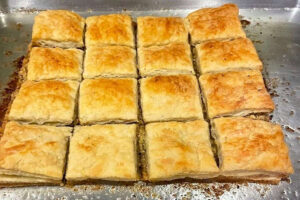
Baklava. Photo courtesy of Bruce Feinstein.
PERSIAN BAKLAVA (pareve)
Makes 18-20 pieces
Cook’s Tips:
- Traditionally uses filo dough. Shani’s shortcut: Pepperidge Farm Puff Pastry.
- Ground almonds, cardamom and rose water may be bought from a spice shop.
Ingredients:
For the syrup: 2 cups sugar, 1 cup water, 6 tablespoons rose water
For the filling: 2 ½ cups ground almonds, 1½ cups confectioners’ sugar, 3 tablespoons ground cardamom
1 (17-ounce) package puff pastry, thawed
¾ cup margarine, melted
ground pistachios (optional)
Directions:
Preheat oven to 350 degrees.
Prepare the syrup: Mix the sugar and water in a medium saucepan. Stir to dissolve the sugar. Bring to a boil over a medium-high heat. Add the rose water. Set aside.
Prepare the filling: In a bowl, combine the almonds, sugar and cardamom. Set aside.
To assemble: On a rimmed cookie sheet, spread one sheet of pastry. Brush generously with melted margarine. Sprinkle the almond filling over top, spreading evenly to cover. Top with a second pastry sheet. Brush with remaining melted margarine. With a sharp knife, cut the baklava into small squares. Bake in a preheated oven for 20 to 25 minutes. If not golden brown, place under the broiler for 3 minutes. Watch carefully! Remove from broiler or oven. Pour the syrup over top. Garnish with ground pistachios. Arrange on a platter. Serve warm or at room temperature.
Ethel G. Hofman is a syndicated American Jewish food and travel columnist, author and culinary consultant.

